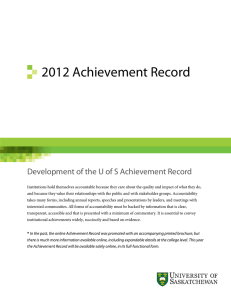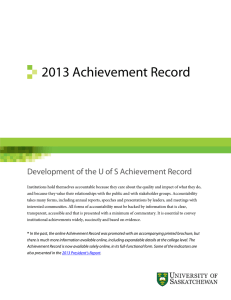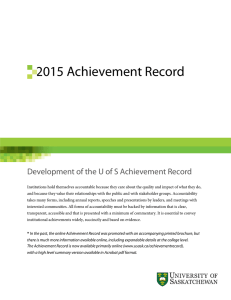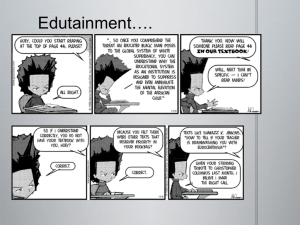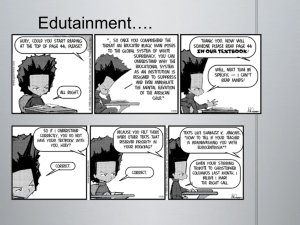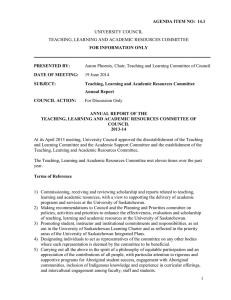2011 Achievement Record Development of the U of S Achievement Record
advertisement
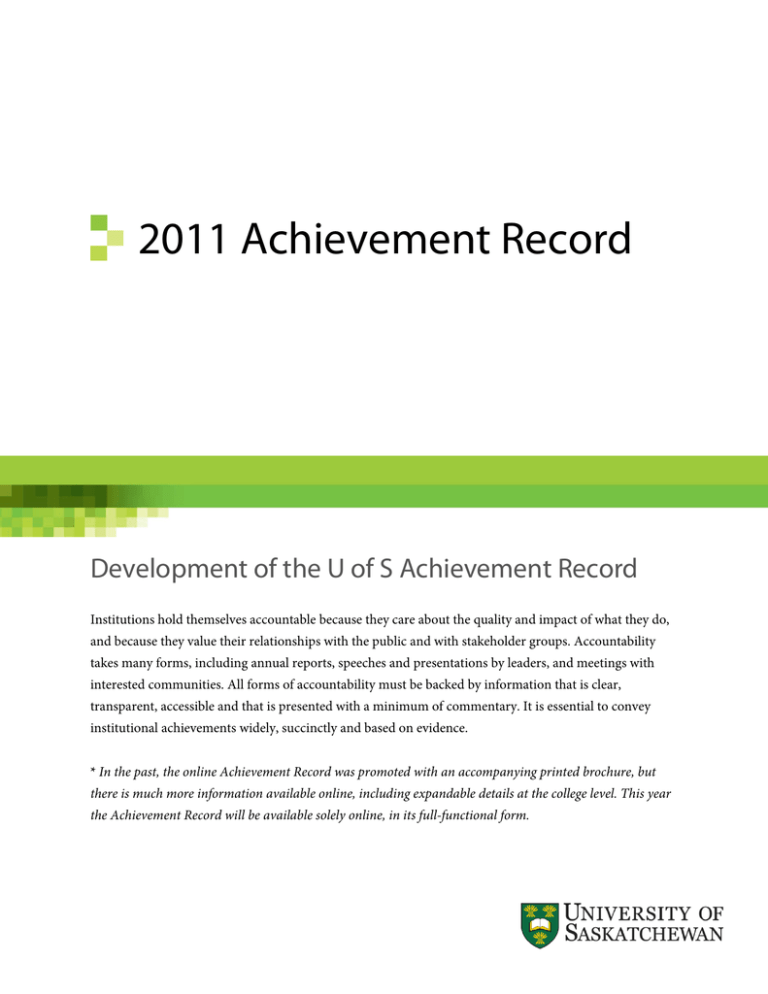
2011 Achievement Record Development of the U of S Achievement Record Institutions hold themselves accountable because they care about the quality and impact of what they do, and because they value their relationships with the public and with stakeholder groups. Accountability takes many forms, including annual reports, speeches and presentations by leaders, and meetings with interested communities. All forms of accountability must be backed by information that is clear, transparent, accessible and that is presented with a minimum of commentary. It is essential to convey institutional achievements widely, succinctly and based on evidence. * In the past, the online Achievement Record was promoted with an accompanying printed brochure, but there is much more information available online, including expandable details at the college level. This year the Achievement Record will be available solely online, in its full-functional form. Teaching, Learning and the Student Experience Students Total number of undergraduate students in each year Student Cohort Aboriginal International 2007/2008 1,753 782 2008/2009 1,597 780 Teaching, Learning and the Student Experience 2009/2010 1,638 852 2010/2011 1,791 902 2 Total number of graduate students in each year Student Cohort Aboriginal International 2007/2008 93 631 2008/2009 101 642 Teaching, Learning and the Student Experience 2009/2010 119 717 2010/2011 161 846 3 Instructional Activity Number of three credit unit equivalent registrations (3CUE) in each year Teaching, Learning and the Student Experience 4 Student Completion Rates Percentage of first-time, full-time direct entry students who graduated within a six-year time frame * Entry and final year of the six-year time frame shown on the graph. Teaching, Learning and the Student Experience 5 Overall Satisfaction Percentage of students who responded favourably to questions about their overall quality of education/evaluation of their entire educational experience Teaching, Learning and the Student Experience 6 Learning Outcomes In progress According to the University of Saskatchewan (U of S) Learning Charter, achieving the learning vision and goals to which we aspire requires the active commitment of students, instructors, and the institution. The U of S is working towards assessment tools for Learning Outcomes that will evaluate students’ knowledge of their discipline or profession, as well as their ability to apply critical and creative thinking to theoretical and practical problems. The University Council’s Teaching and Learning Committee, supported by newly appointed Teaching and Innovation Scholars, is committed to identifying and developing both formative and summative assessments to directly improve student learning outcomes with meetings planned during the academic year 2011-2012. Teaching, Learning and the Student Experience 7 Research, Scholarly and Artistic Work External Funding for Research, Scholarly and Artistic Work Total and Tri-Agency Research Revenue Revenue Source All Other Tri-Agency Total 2007/2008 $162,442,752 $42,367,234 $204,809,986 2008/2009 $143,215,936 $33,906,230 $177,122,166 2009/2010 $114,547,473 $71,111,003 $185,658,476 2010/2011 $155,606,333 $50,987,913 $206,594,246 * In May 2011, the U of S received funding from UBC for construction of the QSMC beam-line at CLSI. This triggered discovery of an agreement that had been signed in the 2008/2009 year but had never been recorded as revenue in university financial records. The construction intended in this agreement had been delayed when a lead design scientist left the project and a replacement had to be found; no funding was received by the university until May 2011. Nonetheless, based on the university's interpretation of its revenue recognition policy, the revenue associated with this agreement should have been accrued when the agreement was signed. The 2011 financial statements includes a restatement whereby $6,485,362 (the UBC agreement total) is included in the 2008/2009 year. The 2008/2009 totals have been adjusted accordingly. Research, Scholarly and Artistic Work 8 Faculty Awards and Honours Number of prestigious awards received by U of S faculty based on national and international awards and honours over a four-year period Research, Scholarly and Artistic Work 9 Output and Impact Academic Ranking of World Universities (ARWU) Commonly known as the Shanghai Ranking 2010/2011 University of Saskatchewan ARWU Ranking 201-300 University of Saskatchewan Scores on ARWU Indicators * The U of S received a score of zero for this indicator in the ARWU. As a result, this indicator cannot be displayed on the graph. Research, Scholarly and Artistic Work 10 Working Together Faculty and Staff Engagement Percentage of U of S faculty and staff who responded favourably to questions about their level of engagement * No survey was conducted in 2007. Working Together 11 Administrative Efficiency Administrative Cost Ratio Administrative and general expenses as a percentage of total expenditures * Data for 2010/2011 is pending the release of data by CAUBO. Working Together 12 Diversified Revenues Monetary donations received by the U of S Working Together 13 Campus Sustainability U of S Rating on STARS (Sustainability Tracking, Assessment and Rating System) 2010/2011 University of Saskatchewan Overall STARS Rating STARS Categories Education and Research Operations Planning, Administration and Engagement Category Average Innovation Credits Overall Score = Category Average + Innovation Credits Working Together Bronze 2010/2011 Total Possible Credits U of S Category Score 100.00 23.7% 99.75 23.1% 99.75 45.7% 99.83 30.8% 4.00 4.00 104 34.8 14 An Engaged University Engagement Partnerships Current number of (a) research partnerships with external partners, (b) centres, (c) existing articulation agreements and (d) experiential learning initiatives and internship programs. Research Partnerships with External Partners Experiential Learning Initiatives and Internship Programs, Existing Articulation Agreements, and Centres * Experiential learning data for 2009/2010 has been revised from last year’s report as a result of a comprehensive approach taken this year to collect this information. All experiential learning initiatives and internship programs listed for 2010/2011 existed in 2009/2010, however, this data was not available last year. An Engaged University 15 National Reputation Ranking of the U of S among 15 medical/doctoral institutions in Canada according to Maclean’s University Rankings * Rankings for 2010/2011 will be available in November. An Engaged University 16 Aboriginal Community Aboriginal Student Success Number of self-identified Aboriginal students who have graduated in each calendar year Level Graduate Undergraduate An Engaged University 2008 26 313 2009 21 266 2010 29 251 17 Aboriginal Faculty and Staff Percentage of faculty and staff who have declared Aboriginal ancestry An Engaged University 18 Principles of the U of S Achievement Record 1. The Achievement Record should be widely discussed and collaboratively used. 2. The Achievement Record should support multiple purposes. 3. To serve its varied purposes, the Achievement Record should be simple. 4. Indicators ought to measure, as much as practical, the things that are meaningful or important to the organization. 5. Initially, the University of Saskatchewan should focus on a practical initial set of indicators, leaving more elaborate development for later if needed. We are working toward becoming an engaged university. Many of the indicators of our success require further development as part of our committment to quality and accountability. 2011 Achievement Record 19
